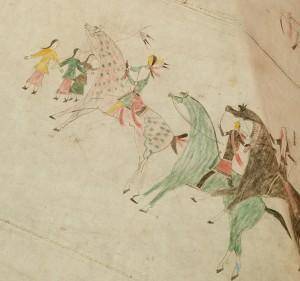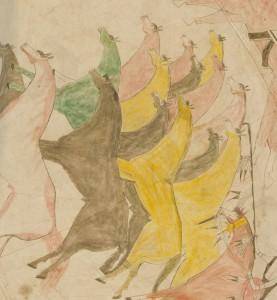Tipi
- Attributed to
- Standing Bear, 1859-1934
This tipi was made by a Lakota artist. The Lakota people lived on the Great Plains, an area roughly between the Rocky Mountains and the Missouri River, from Texas up to southern Canada. Many, but not all, of the tribes who lived on the Great Plains used tipis as their primary form of residence. In most tribes, women were generally both the makers and the owners of the tipis, although men sometimes provided assistance in their construction. They were often made from the skins of buffalo that the men hunted. Women tanned the skins and then sewed them into a pattern to create a semi-circular one-piece covering. The name “Standing Bear” is written on the Denver Art Museum’s tipi, but we are not sure whether this is the name of the artist or possibly the identity of one of the figures depicted. It was not a Lakota custom for artists to sign tipis.
The tribes who lived on the Great Plains moved frequently as they hunted for food and required homes that could be erected quickly and transported easily. The earliest tipis were relatively small but increased in size after Europeans introduced horses to the area, which allowed tribes to carry larger and heavier loads. The materials used to construct tipis were dictated by what was readily available. The tipi covering, for example, was originally made from buffalo hide. The decimation of buffalo herds in the mid- to late-1800s, along with the availability of trade goods, caused a shift to tipis made of canvas. Later, with the building of western-style housing on reservations, tipis as a primary dwelling completely disappeared.
The construction of tipis varied slightly among the different tribes. Generally, three or four foundation poles are tied together near the top while they are lying on the ground. The tripod is then lifted upright and the poles are spread at the base. Additional poles are added to create an oval floor plan. The cover is then attached to the top of a pole and spread across the frame. The two edges of the cover overlap and are secured with wooden pegs. Smoke flaps are controlled by the use of two longer poles. During the hot summer weather, the sides could be rolled up to allow air to flow in and out of the tipi. Extra warmth was gained in the winters by banking snow outside the tipi. An inner layer was also added to the tipi and grass was used as insulation between the two layers. The Denver Art Museum tipi may have been used as a decorative outer cover for another smaller cover, since it lacks evidence of smoke at the top.
The images painted onto the tipi cover probably represent battle scenes. The establishment of reservations ended the nomadic and warrior lifestyle of the Lakota. Military exploits of earlier years became more significant for the Lakota and artists kept the stories alive through their drawings. Enemy tribes, such as the Crow and the Pawnee, are painted in great detail, allowing the viewer to recognize them by their distinctive clothing and hairstyles. Tipis like this one now serve as a historical record of the lives of those who created it.
Details

Canvas
This tipi is made of canvas, with wooden poles for support. Canvas was more readily available than the traditional buffalo hide (buffalo were becoming increasingly rare) and it made the tipi much lighter and easier to transport.

Narrative Painting
This style of painting, referred to as narrative painting, depicts a military scene. Military paintings were done exclusively by men, while women painted abstract patterns. By the late 1800s, Lakota drawings began taking on more realistic proportions. Paintings were not typically painted in chronological order. Images were arranged according to the artist’s preference, recording the essence of an event and not the specifics of time or place.

Horses
Red, green, and yellow horses circle the tipi. Artists often painted horses in a more decorative manner, in colors not normally attributed to the animal. In Lakota society, horses were an important symbol of power and wealth. Artists frequently depicted them as trophies secured in battle or as the prized possession of a rider.

Enemy Tribes
Warriors from the Pawnee and Crow tribes are recognized by their distinctive hairstyles and clothing. The Pawnee warrior is shown wearing high fashioned black moccasins.
More Resources
Websites
The official Lakota Nation website
Books
Marshall, Joseph. The Journey of Crazy Horse: A Lakota History. Minneapolis: Highbridge, 2004.
Marshall takes the reader on the journey of Crazy Horse and his tribe the Lakota. This is an in depth reading about one of the most famous Native Americans to date.
Walker, J.R. Lakota Myth. Lincoln: University of Nebraska Press, 2006.
Walker writes down myths that have been passed down through centuries in the Lakota culture.
Gibbon, Guy. The Sioux: The Dakota and Lakota Nations. Malden, MA: Wiley-Blackwell, 2002.
A comprehensive look at the tribes of the Sioux including the Lakota and its culture, history, and art.
Sneve, Virginia Driving Hawk, and Stephen Gammell. Dancing Teepees: Poems of American Indian Youth. New York: Holiday House, March 1991.
An illustrated collection of poems from the oral tradition of Native Americans.
Children's Books
Sneve, Virginia Driving Hawk. Dancing Teepees: Poems of American Indian Youth. New York: Scholastic, 1991.
For ages 8 and up, this book contains 13 poems that touch upon various American Indian traditions from many tribes.
Mcgovern, Ann. If You Lived With The Sioux Indians. Scholastic Paperbacks, 1992.
This book tells you what it was like to live as a Sioux Indian in North and South Dakota during the years 1800 to 1850.
Funding for object education resources provided by a grant from the Morgridge Family Foundation. Additional funding provided by the William Randolph Hearst Endowment for Education Programs, and Xcel Energy Foundation. We thank our colleagues at the University of Denver Morgridge College of Education.
The images on this page are intended for classroom use only and may not be reproduced for other reasons without the permission of the Denver Art Museum. This object may not currently be on display at the museum.
